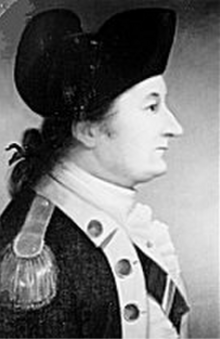Enoch Poor
Enoch Poor | |
|---|---|
 Painting by Ulysses Dow Tenney, 1873, after an earlier portrait by Tadeusz Kościuszko | |
| Born | June 21, 1736 Andover, Massachusetts |
| Died | September 8, 1780 (aged 44) Hackensack, New Jersey |
| Buried | Hackensack, New Jersey |
| Allegiance | |
| Service/ | |
| Years of service | 1775–1780 |
| Rank | |
| Battles/wars | American Revolutionary War |
| Spouse(s) | Martha Osgood |
| Other work | Ship builder, merchant |
Enoch Poor (June 21, 1736 (Old Style) – September 8, 1780) was a brigadier general in the Continental Army during the American Revolutionary War. He was a ship builder and merchant from Exeter, New Hampshire.
Biography
Poor was born and raised in
Poor supported the separatists as early as the
After the disaster in Canada, Poor led the survivors of his regiment in early 1776 back to Fort Ticonderoga. The unit was renamed as the 8th Continental regiment and joined Washington's main army in December 1776 at winter quarters near Morristown, New Jersey.

The
In the
In the

Poor's brigade again spent the winter with the main army, this time at Valley Forge. He led the last maneuvers in the Battle of Monmouth on June 28, 1778. He accompanied the Sullivan Expedition in 1779, leading a brigade in the victory at Battle of Newtown.
Afterward Poor was assigned to
See also
- New Hampshire Historical Marker No. 131: Brigadier General Enoch Poor
References
- ^ Heitman, Francis B., Historical Register of Officers of the Continental Army during the War of the Revolution (Washington, DC: 1914), p. 446
- ^ Fisher, Elijah (1780). "Journal of Elijah Fisher". Journal of Elijah Fisher. Retrieved November 28, 2022.
- ^ "The Mysterious Death of New Hampshire's Enoch Poor, Revolutionary War Hero". newenglandhistoricalsociety.com. Retrieved July 4, 2020.
- ^ Revolutionary War New Jersey
